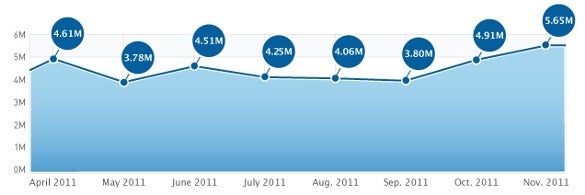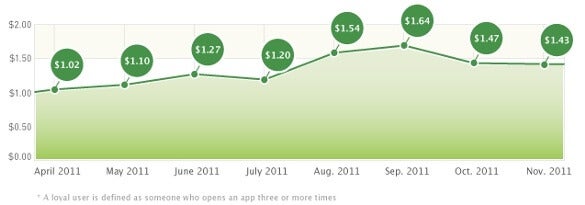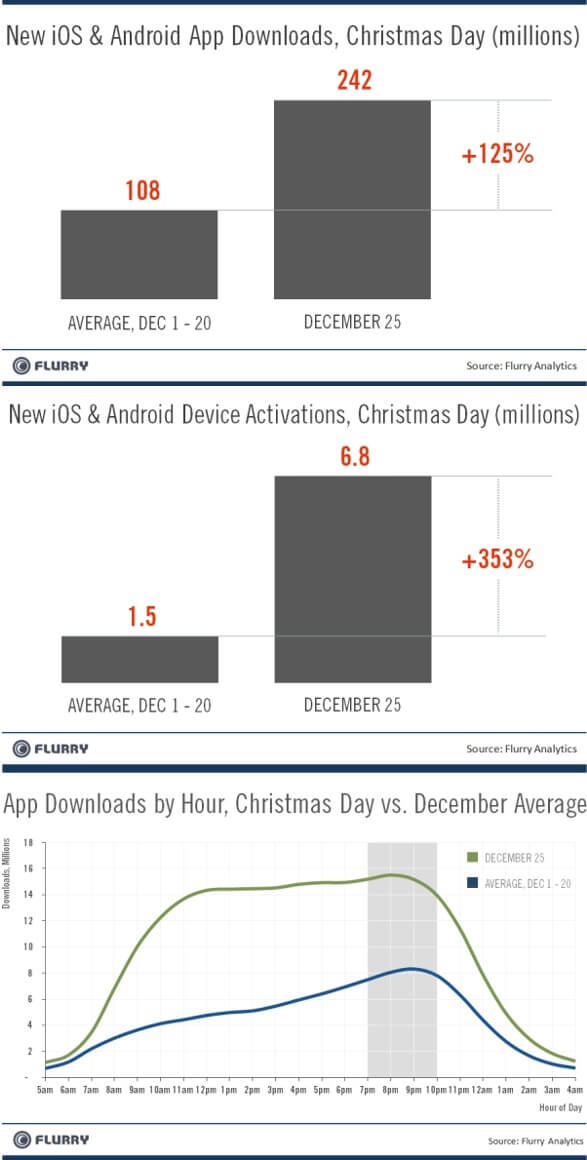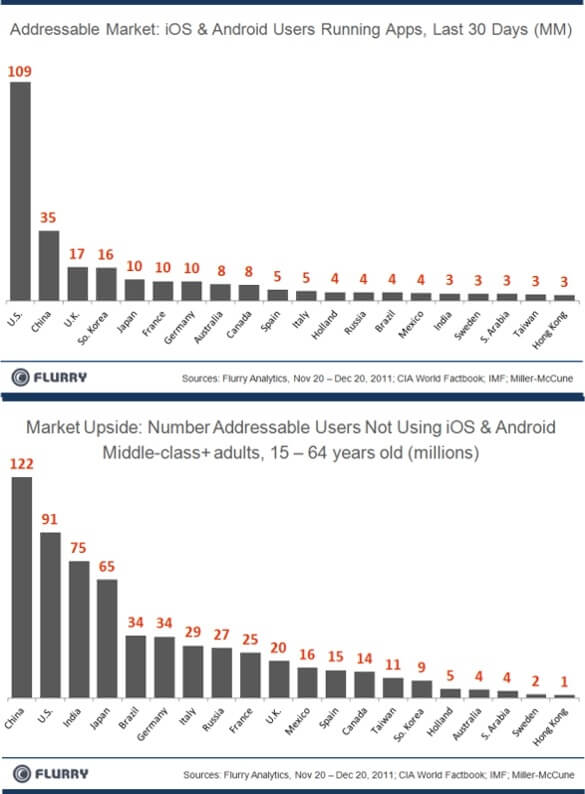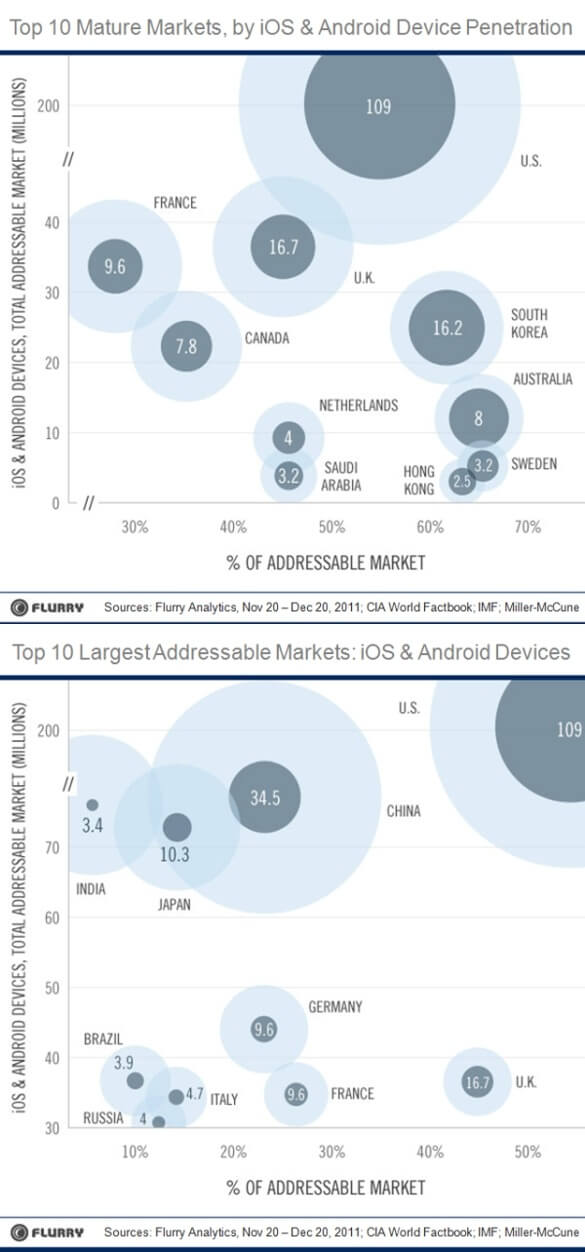iPhone and Android Growing Like Crazy. Downloads up 83%, Phone Activation up 142% from Last Year

Share
Mobile markets love Christmas. Smart phone activations go through the roof, and app downloads explode once the holiday season rolls around. Yet while sales boom at the end of every year, 2011's holiday sales went off like an atomic bomb. Key indicators saw the iPhone app market up 83% from November 2010 to November 2011. 6.8 million smart phones (iOS and Android) were activated on Christmas day alone! That's a 142% increase from last December 25th. Market analysts expect one billion app downloads to be tallied from the 25th to the first of January. This kind of growth in smart phones seems absolutely insane in isolation, but it's part of an exponential rise in mobile devices that has continued unabated since their arrival. 2011 was the biggest year in history for smart phones, and it looks like every new year in the future will be able to say the same. Billions more people are poised to take advantage of the power of iPhone and Android devices - get ready for a global society where smart phones are absolutely everywhere.
Mobile app analysts Fiksu recently released two insightful indexes on the growth of the Apple App Store. The first is the App Store Competitive Index, which shows that not only were downloads up 15% from October '11 to November '11, but they were 83% greater in November '11 than in the previous year, reaching a peak of 5.65 million downloads per day. Interestingly, Thanksgiving week didn't seem to impact download rates. App Store customers also seemed to be more regular in their use. Fiksu's Cost Loyal User Index shows that it cost developers who advertise through their channels about $1.43 to get someone to use an app three or more times. That figure is down four cents from October. In other words, more people are downloading iPhone apps than ever before, and they are easier to get interested in actually using those apps on a regular basis (opening them up to in-app purchases, ads, and other revenue streams).
While Fiksu's data seems reliable, it does have its limitations and bias. First, the indexes are based on the top 200 free apps on the App Store, not a study of the iOS market as a complete whole. Second, and perhaps more importantly, Fiksu is chiefly concerned with delivering new users to app developers, and their Fiksu for Mobile Apps is a platform designed to get users to buy apps. Clearly they have some interest in showing the market booming, and getting cheaper. Still, their platform has reportedly monitored 7.6 billion mobile app actions, including 156 million downloads. And they aren't the only name in the game that's singing the same song.
Flurry, another mobile analyst and advertising agency, tracks market activity through 140k+ copies of their app running on iOS and Android devices. They saw marked increases in downloads through the holiday shopping season, with Christmas Eve and Christmas showing incredible boosts in sales. 6.8 million smart phones were activated in that period, up from 2.8 million in 2010. Andy Rubin, Senior VP of Mobile at Google backed up those numbers, tweeting that Android devices alone saw 3.7 million activations in those two days. The 142% increase from last year is astounding, showing a strong growth in the smart phone market that is matched by app downloads. The Apple App Store hit 10 billion total downloads in January of 2011, and Flurry thinks they'll hit 20 billion total in January 2012. That's ten billion downloads in a single year, double what was seen in the two year span from '08 to '10. Android market hit 3 billion total downloads in May 2011, and may have already reached 10 billion total by December 2011. While only half the total size of Apple, Android is clearly expanding nearly as quickly, if not more so. Flurry expects that smart phone downloads (for iOS and Android combined) will reach one billion just in the time between December 25th and January 1st. The exponential growth in the smart phone market is clear.
The potential for it to continue growing is vast. Flurry looked at the number of active iOS and Android users, and then worked to estimate how many more users might join in the near future. They combined their data on the mobile market with projections from the International Monetary Fund, the CIA world fact book and various other economic models including a study by Miller-McCune. Their results (shown in the graphs below) reveal a huge near term potential market for smart phones that far exceeds current use. And these estimates are conservative – only including adults with adequate income below the age of 64. To grossly summarize: the adressable market for iPhone and Android apps is ready to grow by hundreds of millions. There are 109 million regular smart phone users in the US, but Flurry estimates there are 91 million more to be tapped in that nation alone. China has an additional 122 million. People who could potentially buy these devices and download apps today. The world is far from saturation, which means the exponential growth seen in this market is likely to continue.
Be Part of the Future
Sign up to receive top stories about groundbreaking technologies and visionary thinkers from SingularityHub.


The rapid deployment and adoption of mobile phones around the globe has been well documented and discussed before, and futurists like Ray Kurzweil point to that phenomenon as evidence of the exponential speed at which information technology is evolving and spreading. Yet smart phones, with a development ecosystem that provides rapid response to consumer demand and greatly expands the scope and capabilities of phones, have yet to become a dominant platform for the mobile market. The trends followed by Fiksu and Flurry hint that this is changing. Rapidly. The app market is exploding for iOS and Android. By some estimates, the global middle class as it stands today is 1.8 billion people. With clear advantages over their competitors, iPhone and Android are ready to spread through that population like a virus.
But that's just the high end of app-enabling mobile devices. There are much cheaper smart phones in Africa, and an absurdly cheap tablet in India, each with their own app markets. When considering these lower cost options alongside the expected growth of iOS and Android, the conclusions seem simple: Apps are the way of the future, not just for the West, but for the world. In just a few years, from Shanghai to San Francisco, from farmers to footballers, the smart phone (or tablet) could be the device that rides in all our pockets, and with it will come quick language translations, GPS-enabled digital maps, medical assistance, e-commerce, social media and so much more. The world will fit in everyone's hands.
[image credit: Minnesota Historical Society (via WikiCommons, modified), Fiksu, Flurry Blog]
Sources: fiksu, flurry blog
Related Articles

How Scientists Are Growing Computers From Human Brain Cells—and Why They Want to Keep Doing It

These Brain Implants Are Smaller Than Cells and Can Be Injected Into Veins

This Wireless Brain Implant Is Smaller Than a Grain of Salt
What we’re reading

